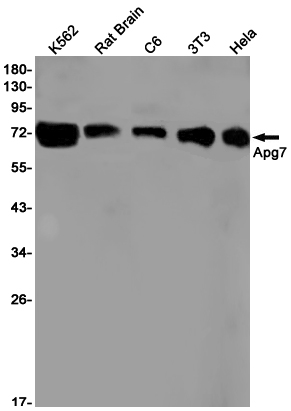-
Product Name
Anti-ATG7 Rabbit antibody
- Documents
-
Description
ATG7 Rabbit polyclonal antibody
-
Tested applications
WB, ICC/IF
-
Species reactivity
Human, Mouse, Rat
-
Alternative names
GSA7; APG7L; APG7-LIKE antibody
-
Isotype
Rabbit IgG
-
Preparation
Antigen: A synthetic peptide of human Apg7
-
Clonality
Polyclonal
-
Formulation
Supplied in 50nM Tris-Glycine(pH 7.4), 0.15M Nacl, 40%Glycerol, 0.01% sodium azide and 0.05% BSA.
-
Storage instructions
Store at -20°C. Stable for 12 months from date of receipt.
-
Applications
WB: 1/2000-1/10000
ICC/IF: 1/20-1/100
-
Validations

Western blot detection of Apg7 in K562,Rat Brain,C6,3T3,Hela cell lysates using Apg7 Rabbit pAb(1:1000 diluted).Predicted band size:78kDa.Observed band size:78kDa.
-
Background
Swiss-Prot Acc.O95352.E1-like activating enzyme involved in the 2 ubiquitin-like systems required for cytoplasm to vacuole transport (Cvt) and autophagy. Activates ATG12 for its conjugation with ATG5 as well as the ATG8 family proteins for their conjugation with phosphatidylethanolamine. Both systems are needed for the ATG8 association to Cvt vesicles and autophagosomes membranes. Required for autophagic death induced by caspase-8 inhibition. Required for mitophagy which contributes to regulate mitochondrial quantity and quality by eliminating the mitochondria to a basal level to fulfill cellular energy requirements and preventing excess ROS production. Modulates p53/TP53 activity to regulate cell cycle and survival during metabolic stress. Plays also a key role in the maintenance of axonal homeostasis, the prevention of axonal degeneration, the maintenance of hematopoietic stem cells, the formation of Paneth cell granules, as well as in adipose differentiation. Plays a role in regulating the liver clock and glucose metabolism by mediating the autophagic degradation of CRY1 (clock repressor) in a time-dependent manner .
Related Products / Services
Please note: All products are "FOR RESEARCH USE ONLY AND ARE NOT INTENDED FOR DIAGNOSTIC OR THERAPEUTIC USE"
